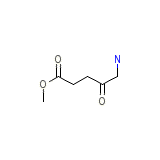Pentasa




Pentasa Brand names, Pentasa Analogs
Pentasa Brand Names Mixture
- No information avaliable
Pentasa Chemical_Formula
C6H11NO3
Pentasa RX_link
No information avaliable
Pentasa fda sheet
Pentasa msds (material safety sheet)
Pentasa Synthesis Reference
No information avaliable
Pentasa Molecular Weight
145.156 g/mol
Pentasa Melting Point
No information avaliable
Pentasa H2O Solubility
Freely soluble
Pentasa State
Solid
Pentasa LogP
-1.026
Pentasa Dosage Forms
Cream for topical administration (160 mg/g of methyl aminolevulinate equivalent to 16.0% of methyl aminolevulinate)
Pentasa Indication
For topical use, in combination with 570 to 670 nm wavelength red light illumination, in the treatment of non-hyperkeratotic actinic keratoses of the face and scalp in immunocompetent patients when used in conjunction with lesion preparation (debridement using a sharp dermal curette).
Pentasa Pharmacology
After topical application of methyl aminolevulinate, porphyrins will accumulate intracellularly in the treated skin lesions. The intracellular porphyrins (including PpIX) are photoactive, fluorescing compounds and, upon light activation in the presence of oxygen, singlet oxygen is formed which causes damage to cellular compartments, in particular the mitochondria. Light activation of accumulated porphyrins leads to a photochemical reaction and thereby phototoxicity to the light-exposed target cells.
Pentasa Absorption
In vitro, after 24 hours the mean cumulative absorption through human skin was 0.26% of the administered dose.
Pentasa side effects and Toxicity
The severity of local phototoxic reactions such as erythema, pain and burning sensation may increase in case of prolonged application time or very high light intensity.
Pentasa Patient Information
Pentasa Organisms Affected
Humans and other mammals














